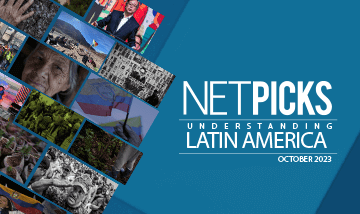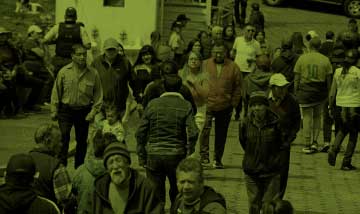Ecuador: Historical victory of the indigenous and popular movements
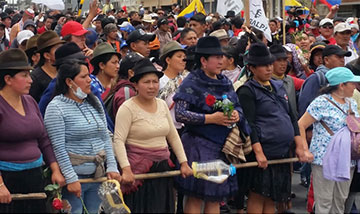
Índice
In an unprecedented victory, Ecuador’s indigenous movement has forced the government of Lenin Moreno to withdraw a structural adjustment decree emitted in compliance with the conditions demanded by the International Monetary Fund (IMF) to grant the country a credit. The adjustment package mainly had included the liberalization of formerly subsided fuel and diesel prices as well as the withdrawal of several worker’s rights. The government gave only in after ten days of popular uprising throughout the country, with heavy riots especially in the capital Quito. The situation was further complicated by intents of followers of former president Rafael Correa to take political advantage of the protests. Ecuador’s political balance of power has shifted: it leaves especially the indigenous movement in a much stronger position, as the most visible leader of the protests in which unions, women, students and also middle classes took part. Now, the country faces the challenge of recomposing after a series of human rights abuses and an outbreak of racism and classism in social networks. Another urgent task, which the government is rather keen to circumnavigate, is to build a profoundly different economic policy which takes plurinationality and inequality into account.
Between October 3rd and October 12th, 527 years after the Spanish invasion to the Americas, barricades have been burning in every part of the Ecuador. The main arteries were blocked, tens of thousands were marching in the streets. Demonstrators occupied the parliament building temporarily, as well as several prefectures.
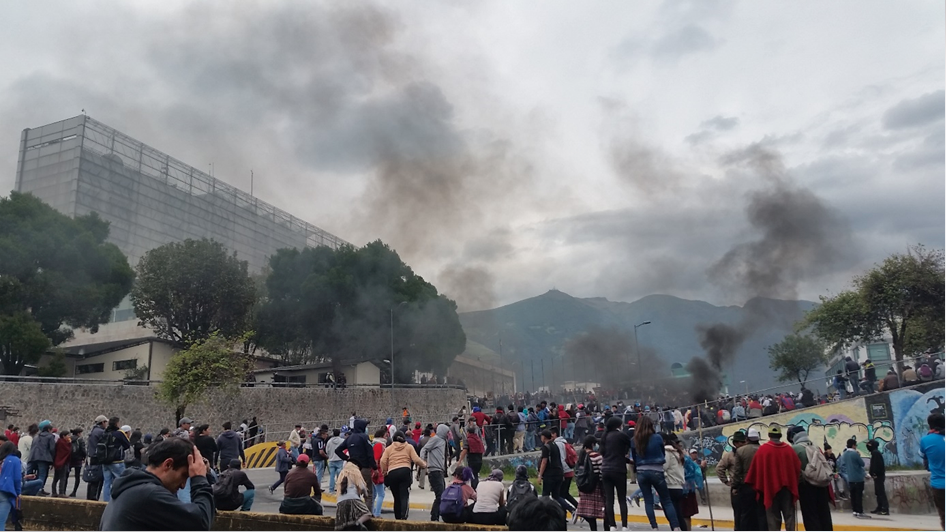
The building of the state comptroller was burnt down. For various days, three of the most important oil fields in the Amazon were paralyzed, hitting the state at its most vulnerable spot. While taxi drivers and transport workers started the protests, but just as quickly put them down again, the indigenous movement began to spearhead the protest movement together with the trade unions. They received strong support from students, women’s organizations and from the urban poor as well as middle classes. The capital Quito and peasants from the surrounding provinces revived a tradition of solidarity which had already supported indigenous protests in the 1990s, donating food, blankets, warm clothes and medicine. Families cooked meals in their homes and brought them to the places where the protesters camped. Sheet metal workers even made shields for the demonstrators who were involved in violent confrontations with police and military.
The government soon declared the country in state of exception, which brought thousands of military personnel and heavy equipment onto the streets. In response, and relying on the constitutional precept of plurinationality, the indigenous confederation CONAIE also declared a state of exception in its territories. It announced that police officers and soldiers who entered those territories without permission would be detained. This happened promptly on several occasions, for example in the province of Chimborazo in the Andes, where nearly 50 uniformed were retained. Some remained captive for several days.
The largest demonstrations of up to 40,000 people took place in the capital Quito. Tens of thousands of indigenous and peasants from all parts of the country came in trucks and set up camp in the central Parque el Arbolito and in surrounding universities, taking turns in order to not exhaust themselves, which gave the protests a long breath. While the indigenous movement called for a massive, but peaceful protest, the marches were accompanied by violent riots, mainly protagonized by students, young urban men and followers of former president Rafael Correa, from which the indigenous leaders clearly took distance.
The government deployed a repression historically unseen in the small Andean country, including attacks on hospitals, universities and women with children. Eight people are known to have died in the confrontations, over 1300 were injured and almost 1200 people detained, according to the latest report of Ecuador’s Ombudsman.[1] But further investigations about human rights abuses only begin, as a delegation of the Inter-American Commission on Human Rights came to Quito on October 28th in order to collect testimonies.
On the night of Sunday October 14th, the government finally acceded to a dialogue under the conditions demanded by the indigenous movement: that it would be broadcasted publicly to ensure maximum transparency, that the presence of community media was accepted and the security of the social leaders involved granted. With the mediation of the United Nations and the Catholic Church, the government finally accepted to cancel decree 883, which had provoked the uprising.
The historical victory of the October uprising marks the indigenous movement’s recovery after ten years of backlash and repression under former president Rafael Correa. But at the same time, social networks show an outburst of openly racist and classist comments. During the protests, upper middle classes were seen patrolling with arms before their gated communities. This political polarization constitutes a severe challenge in a country where certain sectors of the right have felt confirmed by Jair Bolsonaro’s electoral victory in Brasil.
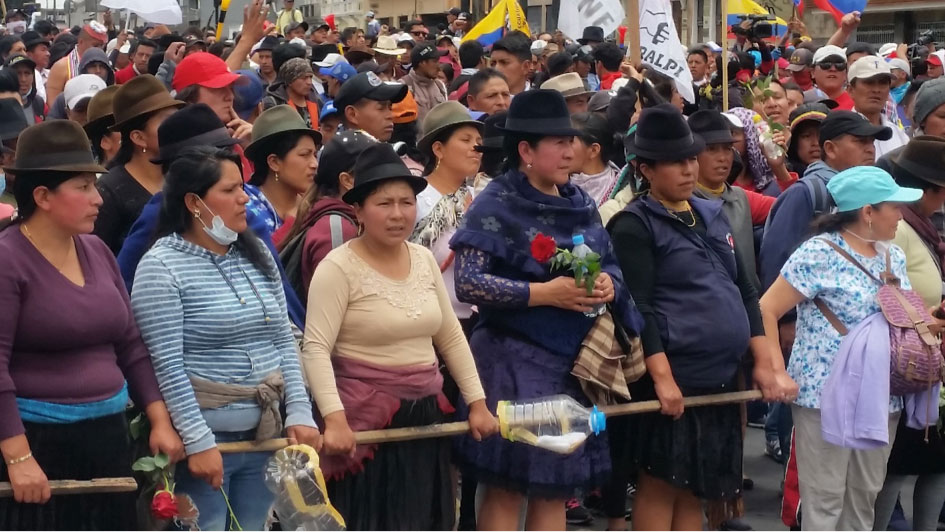
The economic background: Redistribution for the rich
The correspondence of numbers was all too striking: the Ecuadorian government under Lenin Moreno asked the IMF for a loan of four billion and 200 million dollars which was conceded in March 2019, under certain conditions published in a Letter of Intent. In order to keep the disbursements coming in, the government needs to carry out certain structural adjustment measures which are monitored by the IMF, as was customary in the 1990s, including reducing or eliminating government subsidies for fuel; but above all, to make the labor market more flexible revoking certain workers’ rights. Social organizations have calculated that Lenin Moreno has exempted large companies from tax payments of exactly $ 4 billion and $ 295 million in recent years[2]. It is therefore argued that this is a clear measure of redistribution from the bottom up. The broad population must pay to make the elite even richer. The banks have made $ 554 million profit in 2018 alone, while now the salaries of government employees with so-called occasional contracts were to be reduced by a flat rate of 20%. Tens of thousands have already been dismissed from the state apparatus, into an economy that has stagnated and hardly any jobs to offer.
An increase in gasoline and above all diesel prices means an immediate increase in the general cost of living. Bus tickets in public transport had already risen by 10 cents –and returned to their former price after revoking the decree–, but also food and services. Not only because of more expensive transport costs due to the initial increase of 123% in diesel, but also because haulers and middlemen take the opportunity to increase their profit margins. This was the main reason for the massive protests that erupted in Ecuador since the third of October and have paralyzed the country for ten days.
The adjustment package was not motivated by ecological concerns
The measures taken by the government should not be misunderstood as an environmentally friendly policy that aims to redirect people from private car use to public transport – as serious investments in clean public transport to create a real alternative would be a precondition for this. For this reason, also the ecology movement joined the protests. As the NGO Acción Ecológica stated, a consistent environmental and climate policy would require in the first place to withdraw the multiple subsidies and tax exemptions for oil companies, mining and palm oil companies, but those are increasingly expanding their destructive activities in the country with the government’s support.
Rather, inequality would have been deepened even further in a country where the economy is already highly monopolized. Latin America has the most unequal land distribution on the entire planet: the Gini coefficient – which measures inequality[3] – applied to the distribution of land in the region as a whole reaches 0.79, far exceeding Europe (0.57), Africa (0.56) and Asia (0.55). In Ecuador, as well as South America specifically, the inequality is even greater than the Latin American average (reaching a Gini coefficient of 0.81 in 2012 for Ecuador) and has not shown signs of alleviation in the last years.[4] According to ecuadorian sociologist Napoleón Saltos, “the Ecuadorian economy has a high level of transnationalization and monopolization, with a Gini index, in the twenty main branches, which is around 0.97”[5].
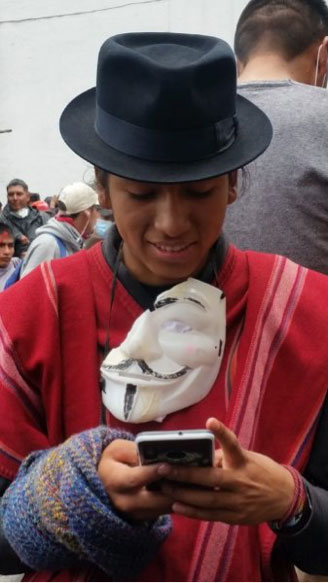
The role of former president Rafael Correa
In 2007, during the first months of its tenure, the progressive government under Rafael Correa had expelled the World Bank and IMF from Ecuador in an act of sovereignty and carried out an audit of the foreign debt, which declared most of it unlawful. Nevertheless, it was precisely this same government that declared war on indigenous peoples and trade unions, since it considered the state the only legitimate actor of social transformation and felt threatened by autonomous social organizations. Protest was systematically criminalized, criminal law tightened and street blockades classified as terrorism. Yellow unions were formed, social organizations aggressively split, an all-embracing propaganda apparatus built until the executive had no significant counterpart left in civil society.
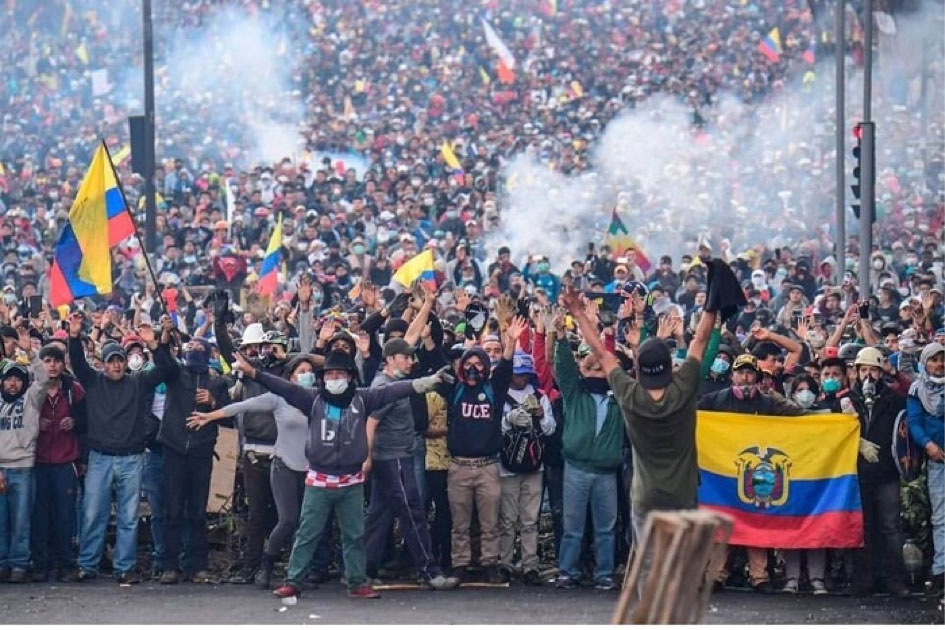
As of 2013, correism also had a two-thirds majority in parliament and could implement whatever it pleased, with a policy that simply transformed the initially promised, profound and intercultural transformation into a process of capitalist modernization, which opened the country further for transnational capital, especially from China. Yasuní National Park, one of the world’s biodiversity hotspots, was cleared for oil exploitation, and for the first time large-scale industrial mining contracts were signed. After international oil prices went down from 2014, the Correa government also returned to the international financial markets and the IMF and began to increase the foreign debt, which is now at 38 billion dollars. Finally, after Correa’s replacement in 2017, it became known that his government had operated corruption in historical dimensions. But most importantly, it left behind a country without significant social organization which could have stood in the way of the subsequent government of Lenin Moreno, who brought the oligarchy directly back into the ministries, especially those related to the economy. It also has radically changed its foreign policies, aligning with the US and rightwing Latin American governments and supporting the idea of a military intervention in Venezuela.
Contrary to what some foreign media claim, the October uprising by no means expressed the people’s desire to bring ex-President Correa back to the government. After the split of his party Alianza País whose label is now owned by his political opponent, President Moreno, and due to the corruption scandals, he lost many of his supporters. They only won two of 23 prefectures in the regional elections in March 2019. Nevertheless, a tough core of Correa supporters and the ex-president himself, who is still in exile in Belgium and cannot return to Ecuador because of several court cases against him, quickly tried to instrumentalize the protests politically and called for new elections. While their criticism of the Moreno government’s deepening of neo-liberal policies is correct, those voices systematically cover up that correístas themselves have paved the way for these policies and already implemented their first steps, for example by signing a Free Trade Agreement with the European Union. The indigenous confederation CONAIE has clearly distanced itself from those appropriation attempts by correístas. In retrospective, it is difficult to say how much influence the correísta instigations really have had on the uprising. Meanwhile, the Moreno government could opportunely claim that the October uprising was only a conspiracy driven by correistas and their allies in the Venezuelan government, instead of an expression of genuine popular discontent. In the last days, several well-known correísta politicians have either been arrested or have asked for political asylum in the Mexican embassy in Quito.
It is noticeable that none of the official announcements of the CONAIE demanded the resignation of President Moreno, but only that of his Minister of the Interior and his Minister of Defense. According to political analysts, the Moreno government sees itself as a transitional government designed to pave the way for the explicit political Right under the Christian Democrat Jaime Nebot. Nebot, whose bastion is the harbor city of Guayaquil on the coast, referred to the indigenous protesters saying that “they should go back to their highlands”, losing legitimacy in the Andean provinces of the country. It is worth saying that Ecuador has already lived through a shift to the right in public discourse and social media in the last two years, including attacks against refugees from Venezuela and increasing aggressivity in social networks. A resignation of Moreno could have catalyzed the rise of the Right to political power, while now on the contrary social organizations have the chance, but also the responsibility, to re-engage more strongly in the social debate about the country’s future.
The challenges of plurinationality and diverse civilizational horizons
It is important to emphasize that the core issues Ecuador’s indigenous peoples are concerned with are rather distant from the logics of electoral and party politics. They were not only aiming at the withdrawal of the IMF package, but also at turning away from extractivism, which continues to advance violently into their territories and threatens their bare existence, both in material and cultural terms. As the indigenous peoples of Chimborazo have explained in a statement, they demand reparation for the plunder since colonial times. And not in hard cash, but in the form of a radically different agricultural policy, which does not aim at eradicating peasants and communitarian subsistence economy, but at strengthening it: Access to irrigation, to non-patented seeds banks and collectively owned fertile lands are their main demands, as well as a systematic promotion of organic farming methods instead of corporate kits which force farmers into the dependence of transnational capital. Plurinationality, the central demand of the indigenous peoples since the 1990s, also includes territorial self-government applying their own judiciary, education and health systems, as well as their own forms of assembly democracy. The right to a mode of living that is not dictated by global capitalism and takes from the modern world only what the community sovereignly decides, that is what Ecuador’s Indigenous Movement basically fights for.
The October uprising also strongly made visible issues of class, inequality and policies of systematic impoverishment. While for the mestizo mainstream and the media, “the indian is poor by nature” as kichwa lawyer Verónica Yuquilema criticizes, the struggle is about ending these policies of colonial drain both nationally and internationally. The indigenous are still depicted as “obstacles to progress and modernization”, an image which Rafael Correa himself underlined strongly during his ten years of rule, while they reclaim that their own modes of living, knowledges, forms of organization and of doing politics be finally recognized and dignified: “We are the State, but we are not taken into account. They say that indigenous peoples and farmers are poor. We labor, cultivate, we feed the cities, but nevertheless we still are treated as poor”, said Amazonian leader Mirian Cisneros during the public dialogue. The constitutional declaration of Ecuador as a plurinational country still has a long way to go in order to effectively materialize.
Now, after the repeal of decree 883, the struggle for future economic policies and more generally, a new country project has just begun. A commission of social and indigenous leaders as well as government representatives has been given the task to work on a new decree that would formulate solutions which both grant the country liquidity while not charging the poorest with the costs. It is quite possible that a failure of this commission will lead to renewed tensions in the country. The CONAIE has called in a popular parliament to work on proposals, while the government seems determined to downplay the importance of indigenous voices by a strategy of systematic de-legitimation, which by its methods strongly reminds the era of correísmo. It is a crucial moment, in which social leaders must protect themselves, and be protected, from multiple aggressions, attempts at criminalization, co-optation and division. In fact, charges already have been formulated against many indigenous leaders that will keep them busy for months and capture many of the funds the movement has gathered through donations during the uprising. Mainstream corporate media, as well as the handful of liberal opinion-makers accustomed to having the power of definition over historical events, label the indigenous leaders either as terrorists or ignorants, appealing to the wide repertoire of racist characterizations that has been built along history. Others – including voices from the government – prefer to blame venezuelan migrants for the riots, further inciting xenophobia.
All these are actions to avoid that Ecuador takes on the principal challenge that it now faces: Organizations, militant intellectuals, we all must resume with this enormous transformative social energy that once led to the Constituent Assembly. The task is to make a great minga, a community effort, to decolonize, depatriarchalize, to build a fair, equitable country which bets on its diversity as a great wealth, recognizes its agricultural vocation with height and manages to get rid of the clutches of globalized capitalist markets. And to hold up the strong experience of festive solidarity, of genuine equality in action, that has characterized Ecuador during the October uprising.
* Miriam Lang is a professor at the Universidad Andina Simón Bolívar in Quito.
[1] For the report see https://www.dpe.gob.ec/la-defensoria-del-pueblo-presenta-septimo-informe-con-resultados-de-la-vulneracion-de-derechos-durante-el-estado-de-excepcion/
[2] See, for example, this open letter to the IMF: https://amazonwatch.org/assets/files/2019-10-21-conaie-letter-to-the-imf.pdf
[3] The GINI index shows inequality on a scale from 0 to 1, where 0 is the lowest inequality index and 1 is its maximum.
[4] See Kaltmeier, Olaf (2019): Refeudalización. Desigualdad social, economía y cultura política en América Latina en el temprano siglo XXI. Guadalajara: CALAS, p.57 for the data on the región, and http://cdes.org.ec/web/la-tierra-en-la-decada-ganada/ for those on Ecuador.
[5] https://contrahegemoniaweb.com.ar/de-paquetazos-y-resistencias-no-son-medidas-es-un-modelo



